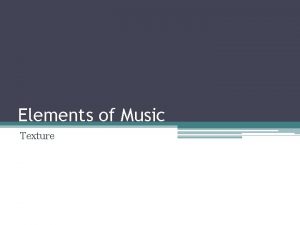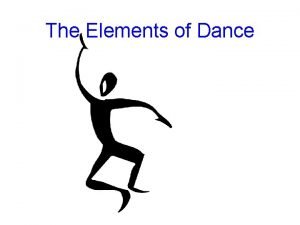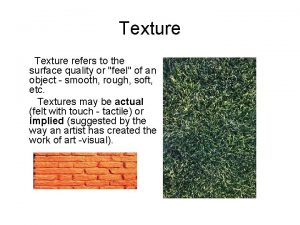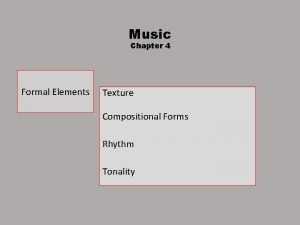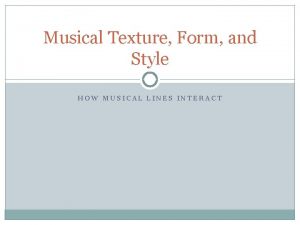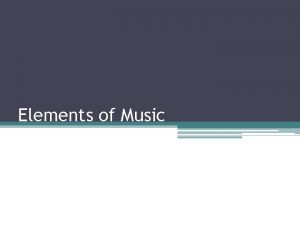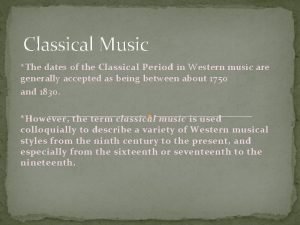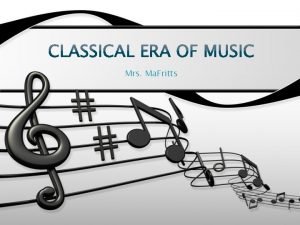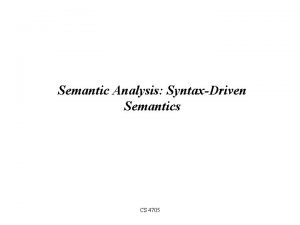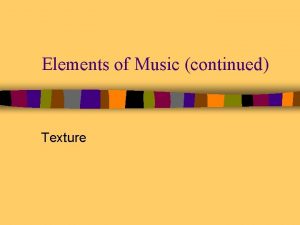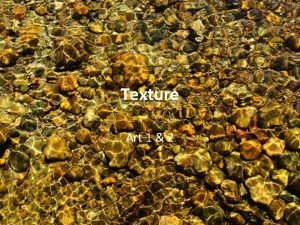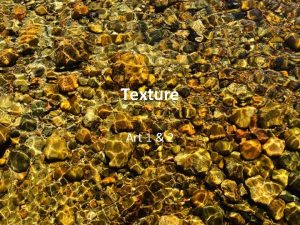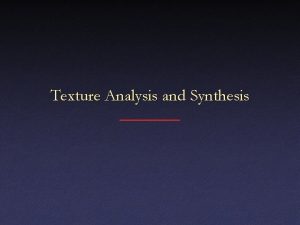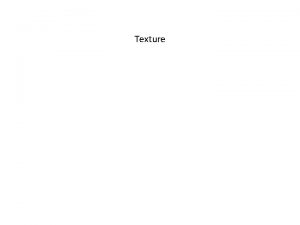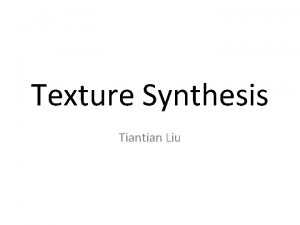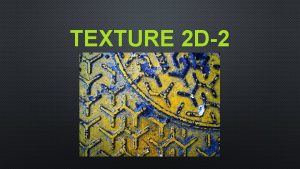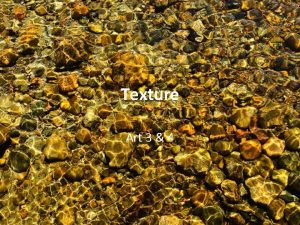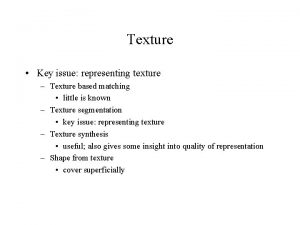Music Chapter 4 Formal Elements Texture Compositional Forms


















- Slides: 18

Music Chapter 4 Formal Elements Texture Compositional Forms Rhythm Tonality

Texture refers to the way composers use melodic lines in their compositions. (page 122) Monophony- a single melody without accompaniment. Polyphony- more than one melody of relatively equal interest. Homophony- a single melody is supports with chords.

Monophony Examples Gregorian Chant Medieval Music Manuscripts Traditional Indian Raga- a traditional Hindustani form, made up of a limited number of notes in a particular melody. Traditional Islamic Music from Spain, North Africa Maquam- traditional Islamic form, similar to a raga. Nova Math and Music Esperanza Spalding about 13 minute in Christian and Muslim playing ouds Catinas de Santa Maria 13 th century

Polyphony Examples What is a Fugue? Basic Polyphony Bach's "Invention" Terms: fugue, round, imitiation Lady Gaga Fugue Bach Harpzichord Abanian Folk Polyphony Medieval motet Machaut Quant en moi

Homophony Examples Most Pop songs in the west are homophonic, with the single melody line supported by other notes forming chords. Homophonic Texture Homophony began to replace polyphony in Europe during the 15 th century. Palestrina Renaissance mass Mozart sonata form, classical diagramming the Sonata Form in Eine Kleine Nactumusik Sweet Honey in the Rock 5 part harmony

Compositional Forms (see pages 113 -15) “Classical” Forms Jazz Forms Mass Fugue Sonata Concerto Symphony Blues Ragtime New Orleans (early Jazz) Swing Be-bop/hard jazz Free Jazz

Concerto: an extended composition for a solo instrument and orchestra. Usually in 3 parts- fast, slow, fast. The concerto form was developed during the 1600’s in Europe. This corresponds to the Baroque period. It was popular among Classical and Romantic composer and is still used in contemporary symphonic music. Vivaldi’s “Winter Concerto, ” Baroque Gidon Kremer Beethoven Concerto for Violin, Cello, Piano, Romantic Barenboim, Ma, Perlman

Symphony an extended composition written for orchestra, usually consisting of multiple distinct sections or movements (often 4) with the first movement in sonata form. Symphonies are scored for string (violin, viola, cello and double bass), brass, woodwind, and percussive instruments. Symphony orchestras can be small or large, 30– 100 musicians. In the 18 th century they grew to great size.


Symphony Romantic composers also developed a more personal style Increased expressive effect Abandoned classical precision and loosened form Unexpected shifts in meter and tempo BBC Eroica Dramatization Eroica Michael Tilson Thomas Beethoven (1770 -1827) studied with Hayden in the classical school, moved toward full romantic – he is a bridge between the too. Eroica Documentary with Michael Tilson Thomas

Ragtimedeveloped from Military March ragging the beat or syncopationnotes fall between the beats Influenced by the traditional Cake walk dances Forerunner of Jazz Highly structured Left hand plays steady beat- alternating bass note and chord- stride piano Right hand plays melody in syncopated rhythm Maple Leaf Rag Piano roll Bio Scott Joplin (1868 -1917)

Blues Origins in labor chants Bio Began to be accompanied by Banjo, guitar, piano Many varieties. Memphis, Delta, Chicago All have in common Simplicity of structure Dominant chord structure Blue notes – minor sound 12 bar blues tutorial Jelly Roll Morton The Crave Jelly Roll Blues 1980 s commercial. Lomax recording Oscar Peterson Blues Peterson in Berlin/Salute to Bach Jelly Roll Morton, 1885 -1941 First jazz musician to compose – to write down the music

More Blues. Bessie Smith • Bessie Smith Ain't Nobody's Business • Bio

New Orleans Jazz Louis Armstrong Considered by many to be the father of jazz Developed improvisatory solo as a feature of the jazz style “Rhythmic displacement” Armstrong would stagger the placement of an entire phrase, as though he were playing behind the beat. More relaxed than Ragtime Louis Armstrong West End Blues Louis Armstrong 1907 -1971

Big Band/Swing Duke Ellington 1899 -1974 Most prolific and significant composer in Jazz history Took jazz into the format of extended works Utilized the particular sounds of individual players Composed across sections 1930 mood indigo Selena and the Blake Jazz Ensemble Caravan 1936 caravan ellington

Hard Bop Mingus Parker and Davis Night in Tunisia Art Blakey and the Jazz Messengers Tunisia Coltrane Equinox

Synthpop • Documentary BBC 52 minutes

Detroit Techno warningcursing in this video Detroit Techno Detroit Photographs More Detroit Photographs- 1967 Marbles Plastikman Juan Atkins Carl Craig
 Musical texture definition
Musical texture definition Element of dance
Element of dance Music music music
Music music music It refers to the surface quality or feel of an object
It refers to the surface quality or feel of an object Beats organized into recognizable/recurring accent patterns
Beats organized into recognizable/recurring accent patterns Formal elements of music
Formal elements of music Polyphonic monophonic homophonic
Polyphonic monophonic homophonic How to describe texture in music
How to describe texture in music 1750 1825
1750 1825 Characteristics of renaissance music
Characteristics of renaissance music What are the dates for the classical time period
What are the dates for the classical time period Texture of baroque music
Texture of baroque music Classical melodies are tuneful and easy to remember
Classical melodies are tuneful and easy to remember Compositional modes for digital media
Compositional modes for digital media Inverse compositional spatial transformer networks
Inverse compositional spatial transformer networks Compositional human pose regression
Compositional human pose regression Chemical layers of the earth
Chemical layers of the earth Stylistic meaning in semantics examples
Stylistic meaning in semantics examples Semantics vs syntax
Semantics vs syntax
